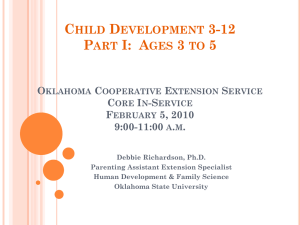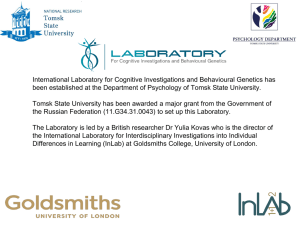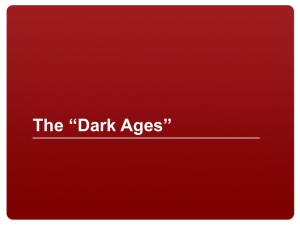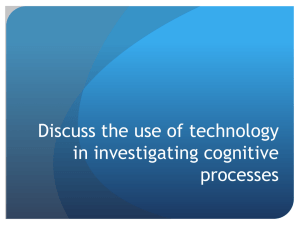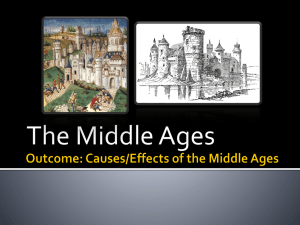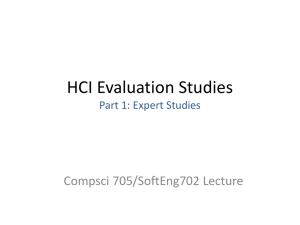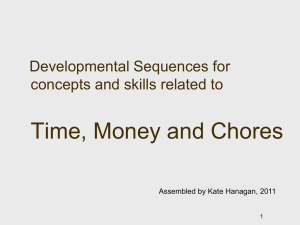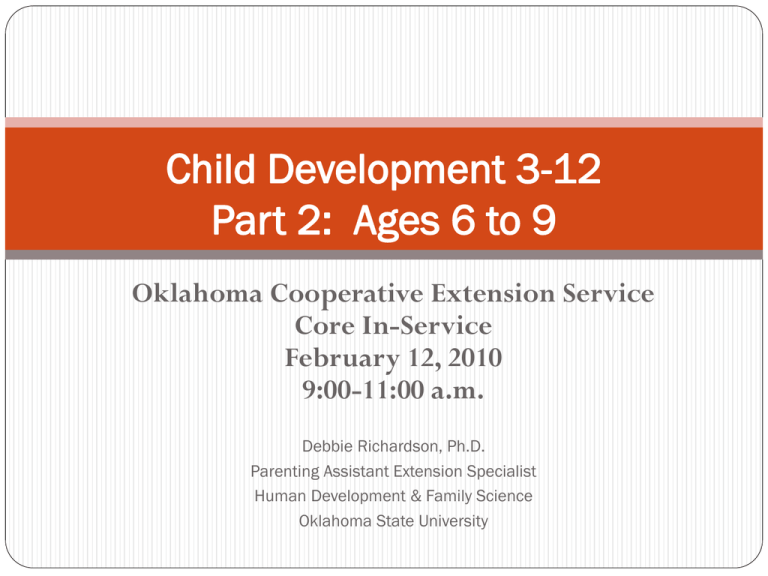
Child Development 3-12
Part 2: Ages 6 to 9
Oklahoma Cooperative Extension Service
Core In-Service
February 12, 2010
9:00-11:00 a.m.
Debbie Richardson, Ph.D.
Parenting Assistant Extension Specialist
Human Development & Family Science
Oklahoma State University
Introduction
Welcome
Centra instructions
Overview of in-service
Resource materials
2
In-Service Objective
Extension Educators will be able to describe
growth, tasks, behaviors, and abilities of 6 to 9
year-old children including physical, cognitive,
emotional, and social development.
3
Domains of Development
Physical
Cognitive
Social
Emotional
Ages 5-7, skills in all domains are emerging
Ages 6-8, beginning to consolidate growth in all domains
Learning fundamental communication, math and problem-
4
solving skills
Expanding social and community awareness
Physical Development
Ages 6-9
Growth
Rate of physical growth is slower Eyes reach maturity in size
6
– occurs in spurts
Often 3-6 growth spurts a year,
each lasting about 8 weeks
Height: Generally 2” to 2.5”/year
Weight: Average 5-7 lbs./year
Loss of front primary teeth and
emergence of permanent teeth
about age 6-7 – replace about 4
teeth per year
and function
Brain growth slows - has
almost reached adult size
Head circumference increases
about 1”
Gradual growth of face
Infection-fighting lymphoid
tissues (i.e., tonsils, adenoids)
Individual Development
Significant differences in
appearance including height,
weight and build
Heredity, nutrition, normal
developmental variation and
physical activity can all affect
rate of growth & development
AAP recommends well-child
visits at 5, 6, 8, and 10 years
7
Motor Abilities & Skills
Fine and large motor skills
Muscle coordination and control are still uneven and
incomplete
Muscular strength, hand-eye coordination, and stamina
continue to progress rapidly allowing older children the
ability to perform increasingly complex physical tasks (e.g.,
dance, sports, musical instruments)
Skills/abilities influenced by growth, age, level of practice
performing tasks, and individual child’s innate abilities
8
By age 5-6
Large motor
Stand on one foot for 10
9
seconds or longer
Hop
Somersault
Swing
Skip
Fine motor
Copy geometric patterns
and print some letters
Draw a person with a body
Use fork, spoon, and
sometimes table knife
properly
Able to take care of basic
hygiene (e.g., bathing,
teeth, toliet)
By age 8-9
More graceful with movements
and abilities
Master eye-hand coordination
Manipulative skills increase
Dresses and grooms self
completely
Can use tools more effectively
Good printing and writing
10
Sleep
Need about 9-11 hours per night
Consistent sleep schedule and
Increasing demands from school,
bedtime routine
Quiet, private time
Bedroom – dark, cool and
quiet, no TV or computers
Avoid caffeine
sports, other activities
TV, computers, video games,
caffeine can lead to difficulty falling
asleep, nightmares and disruptions
Sleep problems, disorders common
Poor/inadequate sleep can lead to
mood swings, behavioral problems,
cognitive problems that impact
ability to learn in school
11
Cognitive Development
Ages 6-9
Cognitive Development - Piaget
Preoperational Stage: 2-7 yrs
13
Concrete Operational Stage: 7-12 yrs
Thought processes (operations) become organized and
integrated with one another – allow logical thought
Ability to classify objects in multiple ways, order objects in a
logical sequence
Make rational judgments and perform operations about
concrete or observable phenomena
Abstract thinking, yet still limited (no hypothetical or
complex abstractions)
Cognitive Development - Piaget
Better understanding of time and space, but not yet able to
correctly place events in time sequence
Some reversibility - quantities moved can be restored (e.g.,
3+4 = 7 and 7-4 = 3), understand changes in form of
object
Deductive reasoning – ability to draw conclusions from
given facts & info
Relativism – realize other’s thoughts & perspectives differ
from own, can be wrong themselves, their own and other’s
thoughts/feelings do not reflect reality
14
The Evolving Brain
Continued brain development underlies changes in
cognitive skills
Different parts of the brain start to function more
effectively as a coordinated system
Newly developed functions enable children to coordinate
their thinking and their behaviors more effectively
Pre-frontal cortex is still immature – the part responsible
for good judgment and control of impulses
15
Metacognition
Process of thinking about thinking
Automatic awareness of own
knowledge and ability to
understand, control, and
manipulate their cognitive
processes
Begins to think about own
behavior and see consequences
for actions
Can think through actions and
trace back events that happened
to explain situations
16
Thinking
Dramatic increase in real-world knowledge – expanding
experiences outside homes, in schools and communities
Fantasy thinking gives way to logical thinking, distinguish
between real & pretend, understand cause-and-effect
Occasionally revert to pre-logical thinking patterns under
stress - normal and results from a healthy, active imagination
Increase in speed and capacity of memory processing allows
17
handling more complex problems; can consider 2 or more
aspects of a problem
Thinking
Learn to control attention and concentrate for longer
periods of time - can obtain and use information more
efficiently
Practicing and paying attention can
improve remembering new things
About age 6, begin to internalize strict moral rules of
behavior (right or wrong) - Can understand and apply
rules, make judgments, and want rules strictly followed
Able to develop simple plans before acting, to achieve
goals, more reliable without adult supervision
18
Attention and Learning
Rarely can sit for longer than 15-20
minutes for an activity
Attention span gets longer with age
May begin projects but finish
few…more about exploring
Best learn through activities
Can talk through problems to solve
them – requires more adult time
and child’s sustained attention
19
Language
Continually increasing
vocabulary
By age 8, can understand
about 20,000 words
Speak with more precision
Begin to understand a word
may have different meanings
Begin to read and write
20
By age 5-6
Recall parts of a story, tell longer stories
Speak sentences of more than 5 words
Use future tense
Recite address correctly
Count 10 or more objects
Correctly name at least 4 colors
Know about common items such as money, food, appliances
Most learn to read by age 6-7, but some as early as 4-5
Simple math, addition & subtraction
21
By age 8-9 (3rd/4th grades)
Can count backward and understand fractions
Reading a paragraph extends beyond deciphering words to
22
understanding content
Writing extends beyond correct spelling and penmanship to
composing a sentence and start paragraphs
Enjoy playing strategy games
Enjoy word play (e.g., puns, insults) to exercise and show off
growing cognitive & language abilities
Mostly think in present terms, but may
think about the future
Social & Emotional
Development
Ages 6-9
Psychosocial Development
Erikson
o Initiative Vs. Guilt (Purpose)
About 3 ½ to 6 years
Feel free to act, create, express self creatively, and take risks.
o Industry Vs. Inferiority
7-11 years
Busily learn to be competent and productive or feel inferior
and unable to do anything well. Tries to develop a sense of
self-worth by refining skills.
24
Expanding Social World
Spend more time outside their homes, in school, with peers, and
25
in activities with other adults and without adults present
Have increased freedom and autonomy to explore the world
Become less dependent on family and less self-centered
Greater physical and cognitive capacities make it possible to be
more responsible for tasks at home and school
Very energetic, like to make things, take risks, and are interested
in accomplishing a task
Need to develop a sense of mastery or
competence by performing tasks
without adult help
Expanding Social World
Changes from fantasy play where imagination is key element to
26
rules-based games with objective to win a competition regulated
by rules
More capable of playing a larger number of children for longer
periods of time and sticking to rules of a game
Belonging and acceptance by peers becomes very important
concern; no longer look to only adults for gratification
Very concerned with justice and fairness
Develop and show social skills (i.e., empathy, compassion) by
observing effect of their own and others’ behaviors toward others
Emotions
Usually able to articulate thoughts Common fears include
and feelings
Although no less articulate than
girls, many boys are not as
expressive mainly due to
socialization to be masculine
By age 9, most boys have
successfully learned to repress
feelings except anger – tend to be
more physically oriented in selfexpression
27
monsters, the dark, the
unknown, school, failure,
death, family problems,
and rejection
6 Year-Olds
Emotions up and down
Plays best with one friend
Thrives on approval
rather than large group
Needs to be reminded of
instructions
Money and rewards of
greater interest
Possessive with belongings;
28
not yet able to distinguish
“mine” & “yours”
Responds negatively at first
then cooperates
Has trouble compromising
Difficulty making choices
Likes to help with routines
7 Year-Olds
Does not listen or take
Plays easily with others
Wants to be part of a group
May be self-absorbed, moody,
Becoming more aware of self
and others
Sensitive to others’ feelings;
may feel others dislike them,
are critical or poking fun
Dislikes individual praise
29
correction well
Responds well to rewards
Procrastinates, easily
distracted, short memory,
tunes out; loses interest
suddenly
Very competitive and does
not know how to lose
Lies because of immaturity
Immature sense of ownership
Fights with words
More modest about body
8 Year-Olds
More outgoing and self-confident
Easily disappointed if people
More self-aware and self-judging;
don’t behave as wished
Talks a lot and gossips
Cannot lose gracefully
Interested in & concerned
about possessions
30
dislikes being teased about
shortcomings
Can respond rapidly to
instructions
Prefers hint/cue rather than a
direct order; responds to glance
Asks for praise; wants time,
attention, affection, approval
Tells tales with some truth
Dramatic, impatient, demanding
Likes to argue, compete, criticize
9 Year-Olds
Quieter; more self-control; can
31
spend more time alone
Increasingly self-confident,
independent, responsible,
dependable, cooperative
Likes to please
Likes organized activities; likes
to be chosen
Friendships are more solid
Sometimes temperamental
May resist/rebel authority and
being told what to do
Great interest in fairness
Group standards more
important than parental
standards
Demanding /critical of others
and self
Self-involved; may not hear
when spoken to; may appear
absent-minded or indifferent
Shows anger at parents but is
loyal to family, friends
Takes criticism or commands
better if carefully phrased
Related Issues
Ages 6-9
Peers & Friendships
Develop ability to communicate
Understand others’ points of view
Enable functioning as part of a group
Learn social rules
Develop personality through interaction
Opportunities for give and take, negotiation of differences,
shared experiences, mutual trust
Naturally curious about relationships between genders, but peer
group usually consists of same-sex friendships and typically deny
interest in opposite sex
33
Self-Concept
Shift in self-esteem – continue to develop a sense of self
and how perceived by others
Measure own worth in a more objective way based on
social acceptance and own sense of competence
Parents who demonstrate close relationship, acceptance,
define clear limits for activities and behaviors, and respect
child’s stage of development and unique individuality help
build high self-esteem
Higher self-esteem → can better develop ways to resist
risk factors for aggression, violence, and other negative
behaviors
34
Stress
Growth & development
School
Peers
Schedule
Problems at home
Pressure to conform to expectations from family,
teachers, other adults
35
Relationships with Parents
Change as children’s competence and
autonomy increase
Parents need to share their control over
children’s lives with the children
themselves
Parents need to change parenting
strategies to incorporate:
reasoning
reinforcement of children’s
understanding of right & wrong
problem-solving & prosocial skills
use of humor
36
Discussion & Questions
37
Wrap-up
Watch video clip and review resource materials
In-service evaluation
Next Session on Ages 10-12: Friday, Feb. 19, 9–11am
38



